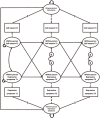The Longitudinal Association between Self-esteem and Depressive Symptoms in Adolescents: Separating between-person effects from within-person effects
- PMID: 31105382
- PMCID: PMC6519152
- DOI: 10.1002/per.2179
The Longitudinal Association between Self-esteem and Depressive Symptoms in Adolescents: Separating between-person effects from within-person effects
Abstract
Many longitudinal studies have investigated whether self-esteem predicts depressive symptoms (vulnerability model) or the other way around (scar model) in adolescents. The most common method of analysis has been the Cross-lagged Panel Model (CLPM). The CLPM does not separate between-person effects from within-person effects, making it unclear whether the results from previous studies actually reflect the within-person effects, or whether they reflect differences between people. We investigated the associations between self-esteem and depressive symptoms at the within-person level, using Random Intercept Cross-Lagged Panel Models (RI-CLPM). To get an impression of the magnitude of possible differences between the RI-CLPM and CLPM, we compared the results of both models. We used data from three longitudinal adolescent samples (age range 7-18; Study 1: N=1,948; Study 2: N=1,455; Study 3: N=316). Intervals between the measurements were 1-1.5 years. Single-paper meta-analyses showed support for small within-person associations from self-esteem to depressive symptoms, but not the other way around, thus only providing some support for the vulnerability model. The cross-lagged associations in the aggregated RI-CLPM and CLPM showed similar effect sizes. Overall, our results show that over 1-1.5 year time intervals, low self-esteem may negatively influence depressive symptoms over time within adolescents, but only weakly so.
Keywords: Self-esteem; depression; longitudinal data; random intercept cross-lagged panel model; within-person effects.
Figures









Similar articles
-
Re-examining the reciprocal effects model of self-concept, self-efficacy, and academic achievement in a comparison of the Cross-Lagged Panel and Random-Intercept Cross-Lagged Panel frameworks.Br J Educ Psychol. 2020 Mar;90(1):77-91. doi: 10.1111/bjep.12265. Epub 2019 Jan 17. Br J Educ Psychol. 2020. PMID: 30657590
-
The Role of Self-Esteem in Protecting Against Cyber-Victimization and Gaming Disorder Symptoms Among Adolescents: A Temporal Dynamics Analysis.J Youth Adolesc. 2024 Apr;53(4):863-876. doi: 10.1007/s10964-023-01890-8. Epub 2023 Oct 30. J Youth Adolesc. 2024. PMID: 37904058
-
Testing prospective effects in longitudinal research: Comparing seven competing cross-lagged models.J Pers Soc Psychol. 2021 Apr;120(4):1013-1034. doi: 10.1037/pspp0000358. Epub 2020 Jul 30. J Pers Soc Psychol. 2021. PMID: 32730068 Free PMC article.
-
Longitudinal effects of sexual minority stigma on depressive symptoms among young men who have sex with men: Distinguish between and within person effects.J Adolesc. 2024 Aug;96(6):1293-1303. doi: 10.1002/jad.12338. Epub 2024 May 20. J Adolesc. 2024. PMID: 38769773
-
Self-concept Clarity and Subjective Well-Being: Disentangling Within- and Between-Person Associations.J Happiness Stud. 2023;24(4):1439-1461. doi: 10.1007/s10902-023-00646-2. Epub 2023 Mar 31. J Happiness Stud. 2023. PMID: 37193058 Free PMC article.
Cited by
-
Longitudinal Relations Between Emotion Regulation and Internalizing Symptoms in Emerging Adults During the Covid-19 Pandemic.Cognit Ther Res. 2023;47(3):350-366. doi: 10.1007/s10608-023-10366-9. Epub 2023 Mar 13. Cognit Ther Res. 2023. PMID: 37168696 Free PMC article.
-
Relational Victimization, Coping Styles and Depressive Symptoms: A Test of Bidirectional Associations in Adolescence.J Youth Adolesc. 2025 May;54(5):1314-1325. doi: 10.1007/s10964-024-02134-z. Epub 2025 Jan 13. J Youth Adolesc. 2025. PMID: 39804525
-
The Longitudinal Associations Between Parental Autonomy Support, Autonomy and Peer Resistance.J Youth Adolesc. 2024 Apr;53(4):1015-1027. doi: 10.1007/s10964-023-01915-2. Epub 2023 Dec 8. J Youth Adolesc. 2024. PMID: 38066317
-
The Longitudinal Relationship Between Self-Esteem, Life Satisfaction, and Depressive and Anxiety Symptoms Among Chinese Adolescents: Within- and Between-Person Effects.Behav Sci (Basel). 2025 Feb 10;15(2):182. doi: 10.3390/bs15020182. Behav Sci (Basel). 2025. PMID: 40001813 Free PMC article.
-
The bidirectional relationships between social isolation and cognitive function among older adults in China: separating between-person effects from within-person effects.Sci Rep. 2024 Dec 30;14(1):31832. doi: 10.1038/s41598-024-83130-y. Sci Rep. 2024. PMID: 39738602 Free PMC article.
References
-
- Abela, J. R. Z. , & Hankin, B. L. (2008). Cognitive vulnerability to depression in adolescents: A developmental psychopathology perspective In Abela J. R., & Hankin B. L. (Eds.), Handbook of adolescent depression (pp. 35–78). New York: The Guilford Press.
-
- Abramson, L. Y. , & Metalsky, G. I. (1989). Hopelessness depression: A theory‐based subtype of depression. Psychological Review, 96, 358–372. 10.1037/0033-295X.96.2.358. - DOI
-
- Akaike, H. (1974). A new look at the statistical model identification. IEEE Transactions on Automatic Control, 19, 716–723. 10.1109/TAC.1974.1100705. - DOI
-
- Beck, A. (1967). Depression: Causes and treatment. Philadelphia: University of Pennsylvania Press.
Grants and funding
LinkOut - more resources
Full Text Sources
